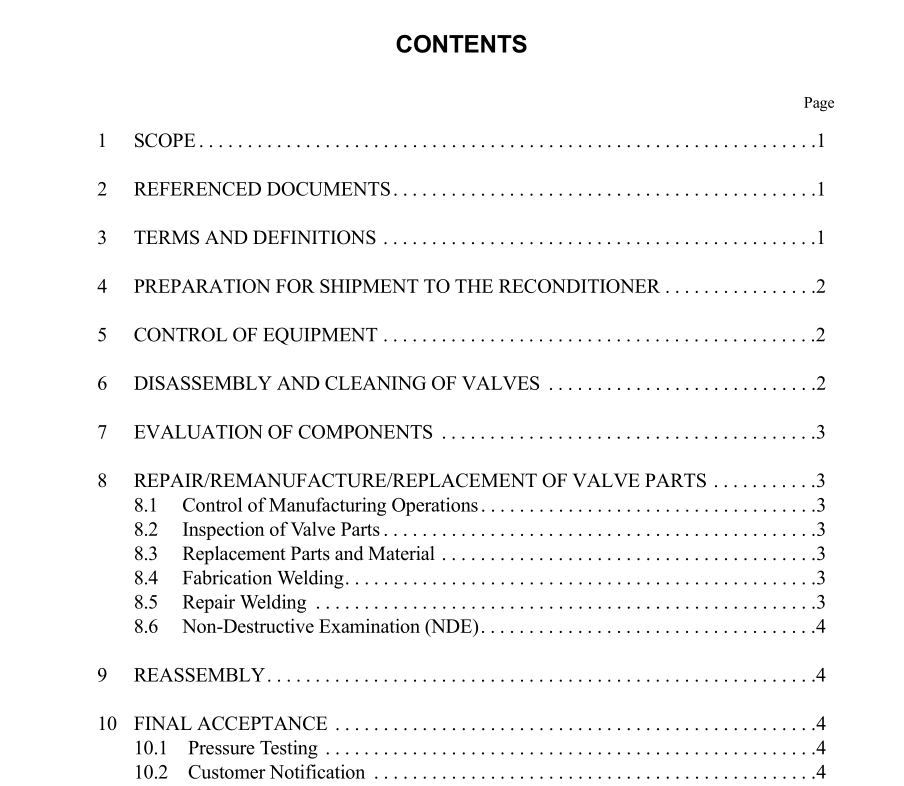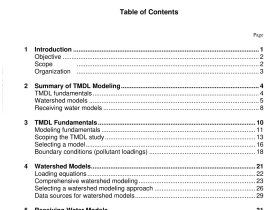API RP 6DR pdf download

API RP 6DR pdf download.Repair and Remanufacture of Pipeline Valves
1 Scope
This Recommended Practice (RP) provides guidelines for the repair and remanufacture of steel ball, check, gate, and plug valves normally used in pipeline applications, as defined by API Spec 6D. This RP covers repair or remanufacturing of end user’s (owner’s) valves for continued service in the owner’s production applica- tions. It does not cover repair or remanufacture of used or surplus valves intended for resale. Repaired or remanufactured valves may not meet API and/or the OEM standard requirements for new valves. The owner is responsible for the correct application of valves repaired or remanufactured per this document. Field repair is outside the scope of this document.
2 Referenced documents
The following documents contain provisions which, through reference in this text, constitute provisions of this standard. For dated references, subsequent amendments to, or revisions of, any of these publications do not apply. However, parties to agree- ments based on this standard are encouraged to investigate the possibility of applying the most recent editions of the documents listed below. For undated references, the latest edition of the document referred to applies. Referenced standards may be either the applicable edition shown herein or the latest revision, provided the reconditioner can show that the latest edition meets or exceeds requirements of the specific edition listed. When the latest edition is specified, it may be used on issue, and shall become manda- tory six months from the date of the revision.
3 Terms and Definitions
For purposes of this document, the definitions in API Spec 6D along with the following definitions apply: 3.1 end user, owner: The entity that holds title to or applies the valve to a particular process.3.2 NORM: Naturally Occurring Radioactive Material. 3.3 OEM: Original Equipment Manufacturer. 3.4 recondition: Repair and/or remanufacture. 3.5 remanufacture: Activities involving disassembly, reassembly, and testing with or without replacement of parts. Machin- ing, welding, heat-treating, other manufacturing operations, or replacement of bodies may be employed. 3.6 repair: Activities involving disassembly, reassembly, and testing with or without replacement of parts. Repair does not include machining, welding, and heat-treating, other manufacturing operations, or replacement of bodies. Buffing, polishing, deburring, and other minimal removal processes are not considered machining and may be employed in repair processes.
4 Preparation for Shipment to the Reconditioner
The owner shall do the following before sending the equipment to the reconditioner: a. All pressure shall be removed from valves and accompanying actuators, tanks, etc. b. Hazardous materials shall be removed and cleaned from the valve and accompanying equipment. c. Valves should be checked for NORM in accordance with the applicable local regulations (region/state/country/province). Valves containing NORM may require special handling and cleaning procedures.
5 Control of Equipment
The valve shall be identified by the owner name/location or other appropriate identifier. Each valve shall be assigned a unique identification number 6 . This number shall be traceable back to the pertinent instructions and or information provided by the owner. A visual inspection shall be conducted to determine if the valve can be reconditioned. If valve cannot be reconditioned, notify the customer for disposition instructions. Disposition may include one or more of the following: a. Salvage useable parts. b. Scrap in accordance with the owner’s instructions. c. Return to the owner.
6 Disassembly and Cleaning of Valves
Valves to be reconditioned shall be completely disassembled. Packing, gaskets, and non-metallic parts shall be removed and dis- posed of in accordance with the owner’s instructions and appropriate safety procedures. The Original Equipment Manufacturer (OEM) tag shall not be removed. Damaged tags which cannot be properly attached shall be retained in the reconditioned valve document file. Tags from previous reconditioning shall be removed and the tag(s) or infor- mation from the tag(s) placed in the reconditioned valve document file. Tags may be electronically scanned or the information recorded and kept in the reconditioning document files. The new identifier number shall be stamped on body, bonnet, cover, closure member, seats (if removed), stem and any other major components, using low stress stencils. If stamping is not practical, parts may be tagged or electro etched, except that all stems and closure elements for valves 2 in. and larger valves shall be marked by stamping. Identification numbers marked on parts shall remain on the parts throughout the reconditioning process. Smaller parts may be placed in a container labeled with the unique identification number. Marking/labeling shall be of a type and material that resists damage, fading, or loss for a period of time consistent with the expected storage period.









